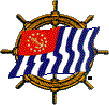
Cruising and Cruise Planning
This site is provided as a means of communications with the USPS National Marine Environment Committee (MEnvCom). We welcome your questions and comments on our courses, seminars and associated materials.
R/C Robert F. Anderson, AP
Stf/C Ronald H. Kessel, SN
Stf/C Judith Swanson, SN
Topics
|
|
|
|
News
US Army Corps of Engineers Closes Dismal Swamp Canal Indefinitely
NORFOLK, VA. Officials at the Norfolk District, U.S. Army Corps of Engineers have announced that the Dismal Swamp Canal will be closed indefinitely.
The canal, which was closed due to extensive damage from Hurricane Matthew in October, requires dredging, debris and tree removal, and an investigation into reports of shoaling at various locations in the canal. The gate repairs alone will take 75 days beginning in January.
Vessels transiting the Atlantic Intracoastal Waterway during the closure may use the Albemarle and Chesapeake Canal. The controlling depth of the canal is 12 feet. The lock and bridge have operating staff on duty 24 hours a day, seven days a week. (16 Dec 16)
Marinas.com Announced the Boater’s Choice Award Winners for Top Marinas
The top 10 all-around marina winners are:
- Albemarle Plantation, Hetford, NC
- Bay St. Louis Municipal Harbor, Bay Saint Louis, MS
- Canyon Lake Marina, Canyon Lake, TX
- Hyatt River Marsh Marina, Cambridge, MD
- Key West Harbor Yacht Club, Key West, FL
- Marina de Vilamoura, Algarve, Portugal
- Nantucket Boat Basin, Nantucket, MA
- Palm Harbor Marina, West Palm Beach, FL
- River Dunes Harbor Club, Oriental, NC
- Spring Cove Marina, Solomons Island, MD
 Anchoring Now Prohibited in Washington, DC Harbor
Anchoring Now Prohibited in Washington, DC Harbor
The following article is reprinted by permission and the courtesy of the Waterway Guide (www.WaterwayGuide.com).
"Region: Chesapeake and Delaware Bays
Date Posted: Aug 10, 2016
Posted By: Mike Ahart, Waterway Guide
Source: Waterway Guide Staff, Cruising Contributor
Visiting the Nation's Capital is often considered a rite of passage for Chesapeake Bay cruisers and world cruisers alike. The Potomac River meanders through our country's history—Stratford Hall, Mount Vernon, Old Town Alexandria—and culminates at the Washington Channel, where cruisers could dock or anchor just steps from the National Mall, monuments, and the Smithsonian. But anchoring is now much less of an option.
Most of Washington Channel along the Washington DC Southwest waterfront is now off-limits for anchoring, according to cruiser Terry Hoy and confirmed by the dockmaster at The Wharf Gangplank Marina. "If you anchor, the police will come out and tell you to move," said Hoy. According to both Hoy and Gangplank marina, anchoring is still allowed south of the Harbor Patrol/Police dock (first dock to starboard heading north up the channel), but this area is much more exposed to waves and wakes.
Eight mooring balls were installed in the foul part of the old anchorage several months ago and are available through Gangplank Marina for $25 a night. Gangplank offers a dinghy dock for moored and anchored boats for $10 daily, and Capital Yacht Club offers a dinghy dock at $16 daily with yacht club privileges. Plans call for adding four more moorings, and for new Gangplank Marina and tour boat docks to extend 200 feet further into the basin (see graphic below). Capital Yacht Club recently installed new concrete fixed docks expanding out to the new channel designation.
 The new 72-slip Market Street Pier Transient Marina docks have been installed, but are awaiting utilities and access before opening to the public. The new marina is part of a public-private partnership between the city and the company developing the District's Southwest waterfront. Construction continues on the waterfront development projects, and The Wharf Gangplank Marina plans to expand and reconfigure its dockage starting this winter and throughout 2017.
The new 72-slip Market Street Pier Transient Marina docks have been installed, but are awaiting utilities and access before opening to the public. The new marina is part of a public-private partnership between the city and the company developing the District's Southwest waterfront. Construction continues on the waterfront development projects, and The Wharf Gangplank Marina plans to expand and reconfigure its dockage starting this winter and throughout 2017.
Since the time the redevelopment plans were available several years ago, the Seven Seas Cruising Association and other concerned boaters have unsuccessfully lobbied to allow boats to continue to anchor in the harbor, citing the significant importance of cruisers visiting from around the U.S. and the world. The only other anchorages near the city are restricted by fixed 18 foot bridges."
Cruising and Cruise Planning Student Manual Reprint
The revised and corrected version of the Cruising and Cruise Planning (C&CP) 2013 student manual has been printed. It is now available through the Educational Department online catalog when ordering student manuals. The revised edition corrects typographical errors and other factual errors identified in the errata sheet. Corrections were also included from members' suggestions. (23 May 16)
Boating to Cuba
The US Customs and Border Protection has posted the latest information on travelling to Cuba by boat. You can find the latest at: https://help.cbp.gov/app/answers/detail/a_id/243/kw/boating%20from%20cuba/session/L3RpbWUvMTQ0MzIyODc4MS9zaWQvTGJpc0pveG0%3D/suggested/1
Essentially, "You must have a license from the Office of Foreign Assets Control (OFAC) to travel to Cuba. The licensing division can be reached at (202) 622-2500." This applies to travelers on boats and aircraft returning to the US from Cuba. The procedures for arrival in Cuba are detailed in a number of excellent books on the subject. Cuban Customs has a webpage: http://www.aduana.co.cu/index.php?option=com_content&view=article&id=2&Itemid=5&lang=en. It does not specify proper procedures for boaters but does give you an idea about some of the documentation.
We will update this page as more information is publicly available on procedures and documents for Cuban cruising. (29 Sep 15)
Updated Errata for 2013 Cruising and Cruise Planning Course
An updated errata sheet for the 2013 Cruising and Cruise Planning Course is available in the Downloadable Material section of this web page. (25 Sep 14)
Glossary Available
A glossary is now available under the Downloadable Material section of this web page. (22 Nov 13)
Coast Guard Termination of Its 2MHz Distress Watchkeeping Service
Effective 01 August 2013, the U. S. Coast Guard terminated its radio guard of the international voice distress, safety and calling frequency 2182 kHz and the international digital selective calling (DSC) distress and safety frequency 2187.5 kHz. Additionally, marine information and weather broadcasts transmitted on 2670 kHz terminated concurrently.
The Coast Guard will continue to maintain a continuous watch on VHF-FM channel 16 (156.8 MHz) and on existing voice and DSC frequencies in the 4/6/8/12 MHz bands as described on the Coast Guard Navigation Center website http://www.navcen.uscg.gov/?pageName=cgcommsCall.
Changes to the student manual, Chapter 8, paragraph 17, and instructor’s slides, Chapter 8, slide 9, should be accomplished. (05 Sep 13)
2013 Cruising and Cruise Planning Course Now Available
A major rewrite of the course has been completed. The 2013 Cruising and Cruise Planning course includes a new Student Manual, Instructor Guide, a Slide Presentation with notes, and a full set of examination questions. In addition to the traditional cruise planning topics, the new manual includes descriptions and tips about some actual cruise routes/areas (the Atlantic Intracoastal Waterway, Inland Rivers, Northwest Pacific Coast, and the Great Lakes). The course also includes a class virtual cruise planning exercise that involves the major elements of cruise planning (charts, guidebooks, route, provisioning/meals, etc.). The new C&CP course materials can be ordered from the Materials Catalog.
Exams for the old Cruise Planning course will be available until 31 August 2014. (09 Mar 13)
Smartphone and Tablet Applications
Applications for smartphones and tablets are multiplying. Many of these applications are useful for the cruiser, racer and day sailor. We are building a list of valuable applications for all boaters. Medical information can be accessed here for the iPhone and iPad and here for Android devices.
For general cruising information, iPhone/iPad apps are here and Android apps are here.
If you know of useful apps, please send the information to the committee and we will share them with other members. (30 Jan 13)
Locking-Through Presentation
See the Downloadable Material section for an excellent PowerPoint presentation on locking-through. (29 Jun 11)
Cruising and Cruise Planning Course Description
There is something very special about the thrill of cruising in new waters and the sense of accomplishment upon completing an extended cruise. To go beyond what most boaters do on a weekend overnight or even a week or so marina hopping requires boaters to leave their normal cruising areas and comfort zones. The Cruising and Cruise Planning course focuses on the planning and preparation necessary for safe enjoyable extended cruises on both inland and coastal waters.
Designed for members who cruise on either a sail or powerboat (owned or chartered)—this course covers the following topics:
- Cruise preparation and planning - General
- Boat and Equipment
- Anchors and Anchoring
- Security
- Chartering
- Cruising Outside the United States
- Crew and Provisioning
- Voyage Management
- Communications
- Navigation
- Weather
- Emergencies
The Cruising and Cruise Planning Course can be comfortably taught in eight two-hour sessions including time for review and the multiple choice closed book exam, but each instructor will determine the pace of the course.
Downloadable Material
Updated Errata for 2013 Cruising and Cruise Planning Course
Some minor errors have been noted in the 2013 Cruising and Cruise Planning Course, and are documented in this updated PDF file (58KB). (25 Sep 14)
Glossary
A glossary for Cruising and Cruise Planning is available in PDF format (111KB). (22 Nov 13)
Locking-Through Presentation
John and Judy Gill produced an excellent slide presentation (PPT, 28,378KB) about locking-through. We are posting it so that instructors and others can have the benefit of it. A separate document (70KB, PDF) is available with the script for the PPT slides. (29 Jun 11)
Weather Log
The following Weather Logs are for use in both the Cruising and Cruise Planning and Weather courses.
- Weather Log in Acrobat format (PDF, 13KB)
- Weather Log in MS Excel format (XLS, 26KB)
Questions or Comments?
If you have any questions or comments about the Cruise Planning course, please contact the National Marine Environment Committee chairman by e-mail, phone or postal service mail. Please be sure to keep your SEO and/or DEO advised of any correspondence you may have with the National committee. Addresses for the National MEnvCom chairman are listed in The ENSIGN and on the Committee Chairpersons page.
We will try to answer your questions as soon as possible, but please allow 5 working days for an answer.
 |
|
|

